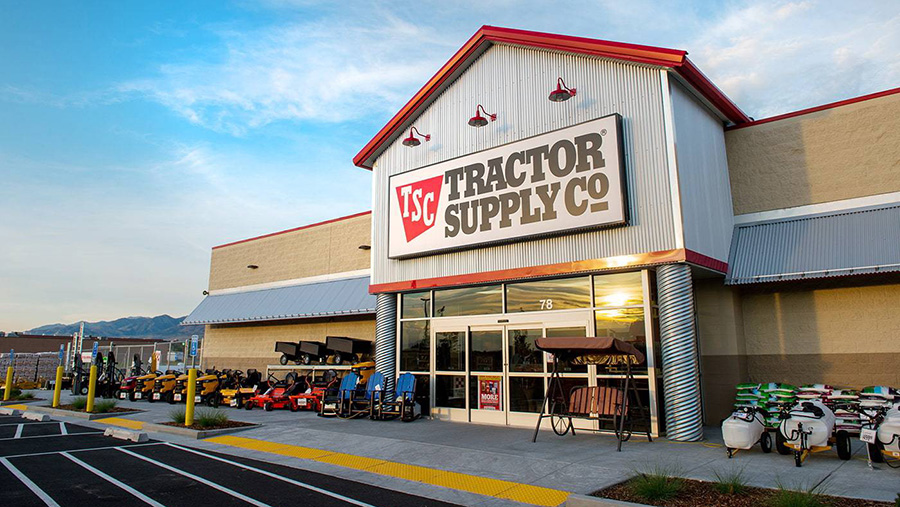Tractor Supply Company slightly lowered its guidance for the year as second-quarter results came in below expectations. The rural retailer also announced a new long-term target of 3,000 stores in the U.S. with a plan to increase annual store openings to 90 per year.
As of July 1, the company operated 2,181 Tractor Supply stores in 49 states.
Profits in the quarter improved 6.2 percent in the second quarter ended July 1 as same-store sales grew 2.5 percent, Earnings of $3.83 per share compared with analysts’ consensus estimate of $3.91. Sales of $4.18 billion in the period were below Wall Street’s consensus forecast of 4.27 billion.
“As has been well documented, U.S. consumer spending on goods is moderating. Additionally, our business was further impacted by seasonal underperformance, particularly in June. Consequently, our second quarter results, while solid, were below our expectations. My thanks and appreciation go out to our 52,000 Tractor Supply Team Members. Through their efforts, we delivered record customer service scores and positive comparable transaction growth in the quarter. Given our first-half performance and our view that our customers will continue to be discerning in their spending for the remainder of the year, we are adjusting our full-year outlook,” said Hal Lawton, president and chief executive officer of Tractor Supply.
“We believe we have a robust, distinct business model in an attractive market. We have achieved remarkable growth and market share gains over the last three-plus years. We remain excited about the many vectors that exist for us to expand our competitive advantages and deliver attractive growth. Today, based on market insights, we are announcing an increase to our long-term store target of 3,000 organic sites. Additionally, we are announcing our intention to increase our annual new store openings to 90 beginning in 2025 with 2024 being a transition year. With significant share opportunity in a total addressable market of more than $180 billion, we have a long growth runway ahead of us as we continue to execute our Life Out Here strategy,” said Lawton.
Second Quarter 2023 Results
Net sales for the second quarter of 2023 increased 7.2 percent to $4.18 billion from $3.90 billion in the second quarter of 2022. The increase in net sales was driven by contributions from the acquisition of Orscheln Farm and Home, new store openings and growth in comparable store sales. Comparable store sales increased 2.5 percent, as compared to an increase of 5.5 percent in the prior year’s second quarter, driven by a comparable average transaction count increase of 1.8 percent and comparable average ticket growth of 0.6 percent. Comparable store sales growth reflects continued strength in core year-round merchandise, including consumable, usable and edible (C.U.E.) products which significantly outpaced the chain average. This performance offset the softness in demand for seasonal goods and declines in big-ticket items.
Gross profit increased 9.3 percent to $1.51 billion from $1.39 billion in the prior year’s second quarter, and gross margin increased 69 basis points to 36.2 percent from 35.5 percent in the prior year’s second quarter. Gross margin continued to benefit from the company’s ongoing execution of an everyday low-price strategy to manage the impact of year-over-year product cost inflation. The gross margin rate increase was primarily attributable to lower transportation costs driven by improvement in the global supply chain and efficiencies from a new distribution center, modestly offset by a negative product mix.
Selling, general and administrative (SG&A) expenses, including depreciation and amortization, increased 10.9 percent to $955.4 million from $861.2 million in the prior year’s second quarter. As a percentage of net sales, SG&A expenses increased 77 basis points to 22.8 percent from 22.1 percent in the second quarter of 2022. The increase in SG&A as a percentage of net sales was primarily attributable to the company’s planned growth investments which included higher depreciation and amortization and the onboarding of a new distribution center. Additionally, higher medical claims contributed to the increase in SG&A as a percentage of net sales.
Operating income increased 6.5 percent to $559.3 million from $525.0 million in the second quarter of 2022.
The effective income tax rate improved to 23.0 percent compared to 23.5 percent in the second quarter of 2022.
Net income increased 6.2 percent to $421.2 million from $396.5 million, and diluted earnings per share was $3.83 compared to $3.53 in the second quarter of 2022.
The company repurchased approximately 0.7 million shares of its common stock for $153.9 million and paid quarterly cash dividends totaling $112.8 million, returning $266.7 million of capital to shareholders in the second quarter of 2023.
The company opened 17 new Tractor Supply stores and three new Petsense by Tractor Supply stores in the second quarter of 2023.
Real Estate Strategy Update
Tractor Supply announced today an update to the company’s long-term store opportunity and several new real estate programs that leverage the strength of its balance sheet and real estate portfolio. These announcements create a longer runway for growth and strengthen the company’s financial model.
Based on its market analysis, the company is establishing a new target of 3,000 Tractor Supply stores in the U.S., an increase of 200 locations from its prior guidance. Additionally, the company anticipates accelerating its annual new store growth to approximately 90 stores per year beginning in 2025, with a step up to 80 new stores in 2024.
Tractor Supply is also updating its real estate development and portfolio management strategy for its store real estate to include owned development and sale-leaseback capability. The owned development program enables the company to capture incremental cost savings through a fixed fee model and has more control in the development process of new stores. The company currently anticipates executing a sale-leaseback transaction of new stores built under this program within a reasonable time after construction is completed.
Additionally, the company plans to periodically execute the sale-leaseback of its existing ownership of 117 stores to fund the cash required by the new development program and to capture the value of its existing real estate. The benefit from the new development program is anticipated to more than offset the incremental rent expense from the sale-leaseback of the company’s currently owned stores. The expectation is that the sale-leaseback of existing stores would be executed routinely over approximately the next eight to 10 years, beginning this year. Given this approach, the total number of company-owned stores is anticipated to remain relatively stable and consistent over time. For 2023, the company expects an after-tax benefit of approximately $0.20 of diluted earnings per share anticipated in the second half of the year from the sale-leaseback of 10 to 15 stores. A similar benefit is anticipated to be achieved each year over the near term.
Fiscal 2023 Financial Outlook
The company is updating its fiscal 2023 financial guidance to reflect its performance from the first half of the year along with its expectations for the remainder of the year, including the positive impact of the updates to the real estate portfolio strategy. The updated fiscal 2023 guidance includes the benefit of the sale-leaseback.
For fiscal 2023, the company now expects the following:
- Sales in the range of $14.8 billion to $14.9 billion, down from $15.0 billion to $15.3 billion previously;
- Comparable Store Sales to increase in the range of +1.3 percent to +2.5 percent compared to +3.5 percent to +5.5 percent previously;
- Net income in the range of $1.12 billion to $1.15 billion compared with previous guidance in the range of $1.13 billion to $1.17 billion;
- Operating Margin Rate in the range of 10.2 percent to 10.3 percent versus 10.1 percent to 10.3 percent previously; and
- Earnings per Diluted Share in the range of $10.20 to $10.40 compared to previous guidance in the range of $10.30 to $10.60.
In light of the updates to the company’s real estate strategy, anticipated capital expenditures for the year are now forecasted to be in the range of $800 million to $850 million, compared to its prior range of $700 million to $775 million. The increase in capital expenditures reflects the implementation of the development program for new store growth that will be fully funded through the sale of existing company-owned stores. Additionally, capital plans for 2023 include opening a total of approximately 70 Tractor Supply stores, completing the Orscheln Farm and Home conversions to Tractor Supply, continuing the Project Fusion remodels and garden center transformations, building its tenth distribution center and opening a total of 10 to 15 new Petsense by Tractor Supply stores.
Photo courtesy Tractor Supply
















